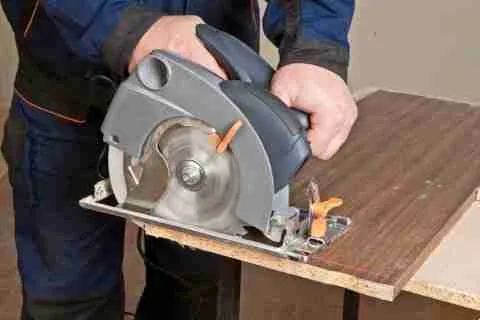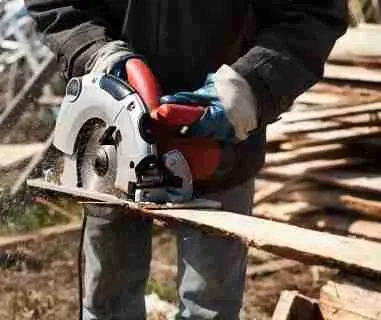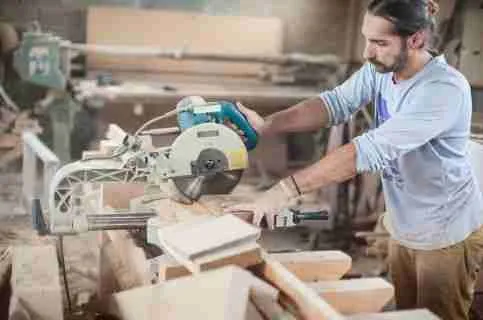Are you a pro, amateur or home DIYer looking to set up a workshop for your woodworking needs? Do you ask yourself the question, what’s the difference between a left handed vs right handed circular saw? There are a two different types of circular saws out there for everyone. The most popular are the Worm Drive and Sidewinder saws in the corded version. Both have great dependability and last a long time with proper care. The two have different side orientations and if you’re using the correct saw for you, then your hand will never cross over the blade.
Which one is right for you? It depends on what your needs are and what hand you’re using to hold the main handle. Left-handers often face challenges when operating a corded circular saw on the right side of their body and they can find it difficult to cut and guide materials with a right-handed circular saw. The same goes for right-handers using left-handed tools. Lefties are all too familiar with this struggle since manufacturers make so many power tools for right-handers. Even keeping those tools within easy reach while on the job can be difficult because there are very few tool belts made for left-handers.
However, there is a caveat to this that some right-handed users complain about and that is a non-consideration of the visibility of the cut line, which funnily enough is an important consideration when lefties use scissors or a rotary cutter.
Table of Contents
Are Circular Saws Right and Left Handed?
The short answer? Yes. There are both right and left-handed circular saws out there and it’s easy to tell the difference when you’re gripping one. Left-handed saws have the blade on the left side of your body, and right-hand saws are with the blade to the right. A blade on the left side allows for better cut line visibility for right-handers, which more and more users prefer. Cordless saws are available on the market, and they are predominantly left-handed. However, they are less powerful or long-lasting than corded ones.
When a lefty uses a right-handed Sidewinder circular saw in their dominant hand, it can be dangerous because when they cut their line or mark, they’ll be holding the saw with their non-dominant hand holding the workpiece near the blade. This can lead to severe injury if they slip and end up cutting themselves.
Left-handers often find they have better luck with a Worm Drive circular saw because those typically have the blade mounted on the left hand side. Worm Drive saws are usually left-handed because they’re built for framers but they can be easy to use for other applications as well.
Sidewinders are typically right-handed. Most manufacturers used to make these saws only for right-handers. However, more options have opened on the market to include left-handed users, and they are confusingly enough, quite popular with right-handed users too!
You may find this bit of information useful. While using a circular saw is a different experience for right and left-handers, using a left-handed drill bit has nothing to do with the handedness of the user.
Circular Saw Blade on Left Side Vs Right
With a left-handed circular saw, the blade is on the left side of your body. With a right-handed saw, the blade is on the right-hand side of your body. When it comes to cut line visibility, lefties have an advantage using the traditional Sidewinder saw because the blade is on the right side. Left-handed Worm Drive saws tend to kick back, so they can be dangerous for novice users, which makes them a better option for experienced right-handed woodworkers who know how to handle this type of saw without injuring themselves.
For a Right Hander Using a Right-handed Corded Circular Saw

Advantages
Right-handed corded circular saws are easier to maneuver for right-handers since their dominant hand will be holding the main handle and the other on the auxiliary handle. This means that there’s no crossing over of the arm over the blade and it’s ergonomically better.
This also ensures that your saw is being supported by the larger part of the wood that’s to the left and not the waste side that will fall away. It also lets you maneuver the wood with your left hand safely away from the blade while your right hand is still on the main handle. This may also prompt you to get a left-handed tape measure to measure your cut lines with your non-dominant hand.
Disadvantages
The problem with traditional sidewinder saws is that cut lines aren’t very visible unless you bend over to your right to see them. With the right hand holding the main handle and the left hand either on the auxiliary handle or on the workpiece, this is not comfortable to do. You may end up with an inaccurately cut piece of wood because of this.

Another minor issue is if you’re making a rip cut on a long but wide plank and you’re walking with the saw as it cuts, the weight of it is not supported because it’s on the waste part of the wood that falls away. It’s not too difficult to handle this issue if you’re using the saw two-handed. If you prefer one-handed use, it’ll be heavier to control and stabilize.
Why Some Right-handers Prefer a Left-handed Corded Sidewinder or Worm Drive
Many right-handers prefer to have cut line visibility above anything else. These users don’t often hold onto the auxiliary handle and instead use their left hand to control the wood. In this orientation, the part of the wood they want to keep is on the right and the waste part is on the left. This way, the weight of the saw is supported by the part that is kept and it’s easier for the user to stabilize it. This is especially useful when making a beveled cut and the weight of the saw is more towards the right.

However, there are two drawbacks to a right-hander using a lefty blade. Most of the sawdust will blow onto you, especially when making a rip cut! The other is the slight risk that you could accidentally cut yourself with the left hand being on the same side as the blade if you use that to control the wood.
For a Left Hander Using a Right-handed Corded Circular Saw
Advantages
A leftie will have an easier time following cut lines or marks that they create since their dominant hand is on the main handle and they don’t have to bend over the blade cover to see where it’s cutting. The non-dominant hand may partially block your view if it’s on the auxiliary handle, but if you’re using it one-handed, the visibility and accuracy will be great.
It’s also easier making a rip cut on a plank one-handed because the weight of the saw is balanced by the part of the wood that stays put.
Disadvantages
Lefties should be very careful when using a right-handed sidewinder since their non-dominant hand will be over the blade if they are cutting against a line or mark. It may not feel ergonomically correct either, as the arms cross each other if using it two-handed.
Conclusion – Should You Get a Left or Right Side Blade Circular Saw?
So, what type of saw should you get? It depends on your preference and level of expertise. Long time circular saw users are used to traditional corded Sidewinders, so they will often prefer a right-handed one. Left-handers among them will have the added advantage of better blade visibility.
However, if you’re a right-hander and find the blade visibility of a left-handed one more desirable for lots of accurate work, and have enough experience to be careful with the blade closer to the hand, then go for a left blade sidewinder.
Experienced users that need more power may find a worm drive better and right-handers will automatically have better cut line visibility. Beginner lefties will have a harder time controlling the Worm Drive circular saw, even though they’re left-bladed, because of kickback and a problem with cut line visibility.
Most wood workers will find the sidewinder saws more user-friendly and easier to control for most wood-working jobs. They can use the Worm Drive circular saws if they expect to work on power-heavy jobs long term.
